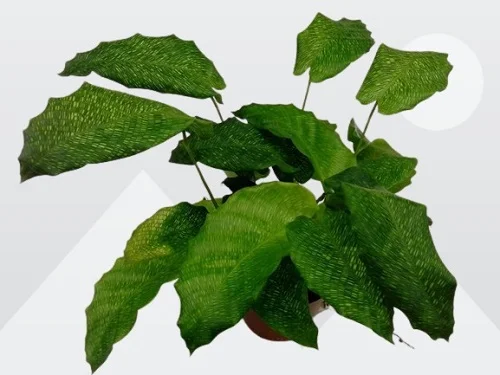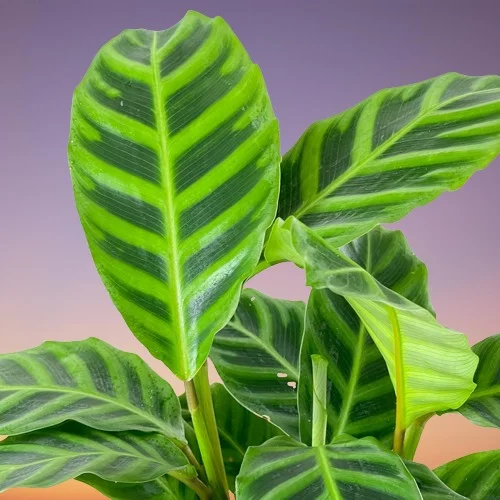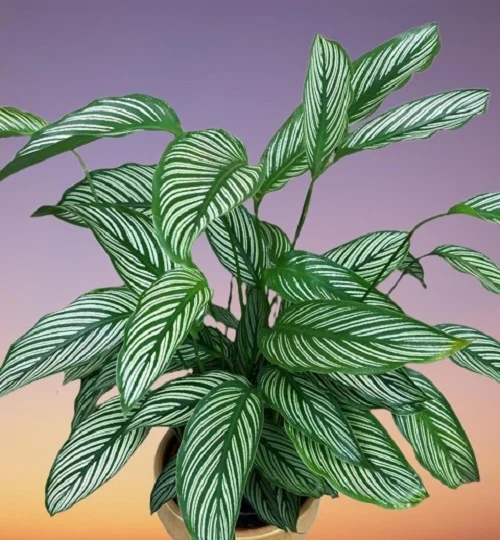Calathea musaica (Calathea Network) Indoor Care, Problems and Solutions
Some links in this post may be affiliate links
Calathea musaica (Calathea Network) grows best in bright indirect light, warm and humid conditions and moderately moist, rich, well-drained soil coupled with monthly feeding in the growing season.
Calathea Network also called Network Prayer Plant is among the popular Calathea varieties and bears arching, glossy, green leaves adorned by a criss-crossing (mosaic) pattern giving it the common name, 'Calathea Network'.

Botanical name: Calathea musaica
Synonym: Goeppertia kegeljanii
Family: Marantaceae
Common name: Calathea Network, Network Prayer Plant
Origin
Calathea musaica also called Goeppertia kegeljanii is native to the rainforests of Brazil where it grows as an understory plant. It is one of the best tropical foliage plants that you can grow in the home or office.
As in its native habitat, it flourishes in bright indirect light (dappled light). Hot direct sunlight can damage the fragile leaves resulting in sunburn and dullness in the leaf color.
Goeppertia kegeljanii also requires a warm, humid environment to mimic its natural habitat. It thrives in moderately moist soil and overwatering or underwatering can lead to brown dry leaves.
Size
Network Prayer Plant is a slow-growing, perennial plant which grows to a height of about 2 feet and about 2-3 feet wide.
Is Calathea musaica toxic?
No. Calathea musaica like other Calathea Plants is non-toxic to both humans and pets as indicated by ASPCA. Calathea musaica is safe for cats, dogs and other pets.
Related Plants
Calathea Network is closely related to the Marantas, Ctenanthe and Stromanthe which are collectively called Prayer Plants in reference to their curious characteristic of closing their leaves at night.
Where to Buy
Are you looking to add Network Prayer Plant to your plant collection? Check them out on Etsy (Link to Etsy).
How to care for Calathea musaica indoors
Caring for Calathea musaica indoors, entails providing bright indirect light (filtered light), average warmth of 18-280C, humidity of 70-80% and moderately moist, rich, well-drained soil coupled with monthly feeding during the growing season.
Calathea Network care requires pruning to keep it neat and also reduce pest and disease infestations. Repotting is needed only when the plant becomes pot-bound. Keep reading for more on the best growing conditions and how to provide them.

Light Requirements
Calathea musaica thrives in bright indirect light (dappled light). Place it near a large, bright window. Keep it away from direct sunlight to prevent scorching of the leaves and loss of leaf color.
Where the natural lighting is not sufficient, instal grow lights to ensure that the plant receives the right amount of light.
For a balanced growth to prevent lopsided growth, regularly rotate the pot to ensure that the plant receives light on all sides.
Watering
Water Calathea Network liberally in spring and summer while allowing the top 2-3 inches of soil to dry out between waterings. Keep the soil moderately moist and avoid overwatering to prevent rotting and yellowing.
Cut down on watering in fall and winter as growth is minimal at this time. Do not allow the soil to dry out completely to avoid wilting and drooping leaves.
Use tepid (room temperature) water to prevent cold shock which can cause stunted growth. Ensure that the water is free of chlorine, flourides and other dissolved chemicals to prevent brown leaf tips and edges.
Use a pot with a drainage hole and well-draining soil to prevent waterlogging which can result in root-rot and death of the plant.
To discourage fungal infestations like leaf spot diseases, avoid wetting the foliage during watering or water from the bottom instead.
Temperature & Humidity
Calathea musaica prefers average warmth of 18-280C. Keep it away from drafts as they cause sudden changes in temperature which can result in stunted growth, wilting and yellowing.
Calathea Network requires a humidity of 70-80%; too low humidity will result in brown leaf tips and edges. To increase humidity, set the pot on a wet pebble tray or use a humidifier. Ensure good air circulation to minimize fungal diseases.
You may also grow the plant in a well-lit bathroom, kitchen or laundry area. Network Prayer Plant can also be grown in a terrarium where a high humidity can be maintained.
Fertilizer
Feed Calathea musaica with a balanced, liquid fertilizer once monthly through out the growing season (spring and summer).
The plant is not a heavy feeder, therefore, feeding once monthly should be adequate. Do not feed in fall and winter as growth is minimal and feeding at this time can lead to fertilizer burn.
Regularly, flush out accumulated salts from the soil by running a stream of water through the soil. Allow the stream of water to run for some time and repeat the process several times.
Potting Soil
The best soil for Calathea musaica is a rich, loose, well-drained soil to prevent it from getting soggy while providing the required nutrients. A mix of 2 parts potting soil and 1 part perlite or vermiculite (for proper drainage) is ideal for this plant.
Repotting
Repot Calathea musaica every 2 years at the beginning of the growing season (spring), only when it becomes root-bound.
Use a pot one size larger than the current one. Ensure that the pot has a drainage hole to prevent the soil from getting soggy as it can lead to root-rot. Check out these pots with drainage holes on Amazon.
Before repotting, water the plant thoroughly at least one day before to hasten establishment as a well hydrated plant suffers less repotting shock.
If the plant is large and has outgrown its current pot, divide it into several sections and use the splits to propagate new plants.
When repotting is done, it may cause the leaves to droop but the plant will eventually recover once it takes root; in about 3-4 weeks.
Pruning & Grooming
Pruning Calathea musaica is easy as it involves removal of dead and yellow foliage to maintain the plant neat and reduce pest and disease infestation. Cut the leaves with a sharp knife or pruning scissors at the base, where the leaf meets the stalk.
Regularly, clean the leaves by damp-wiping with a soft cloth to keep them clean as well as discourage pest and disease infestations.
Calathea musaica Propagation
Calathea musaica Network is best propagated by plant division at the beginning of the growing season (spring to early summer). Dividing the plant at this time hastens establishment as it is in active growth. Unfortunately, Calathea musaica will not propagate from leaf or stem cuttings.
Learn how to propagate Calathea musaica Network in 2 easy ways.

Calathea musaica Problems & Remedies
Calathea musaica Network problems are drooping leaves, yellow leaves, plant dying, brown leaf tips, washed out leaves, pests and diseases among others. Keep reading for more on these problems and how to fix them.
Drooping leaves
Drooping leaves on Calathea Network are due to dry air, inconsistent watering, soggy soil and being pot-bound.
How to fix it
Dry air: To increase humidity, set the pot on a wet pebble tray or use a humidifier.
Inconsistent watering Do not water on a schedule. Water when the top 2-3 inches of soil dry out but do not allow the soil to dry out completely.
Soggy soil: Use free-draining soil and a pot that has a drainage hole.
Being pot-bound Repot the plant into a pot one size larger or divide it into several sections to propagate new plants.
Check out these 10 Causes of Calathea Drooping Leaves and How to Revive It
Yellow leaves
Yellow leaves on Calathea musaica is caused by incorrect watering, soggy soil or too little light.
How to fix it
Incorrect watering: Water when the top 1-2 inches of soil dry out but never allow the soil ball to dry out completely.
Soggy soil: Use a pot with a drainage hole and well-draining soil. In addition, empty the saucer after watering.
Too little light: Place the plant where it will receive bright indirect light or use a grow light if the natural lighting is too low.
Plant dying
Calathea musaica is dying due to inconsistent watering, temperature stress, nutrients deficiency, low humidity, spider mites infestations and root-rot.
How to fix it
Inconsistent watering Water when the top 2-3 inches of soil dry out but do not allow the soil to dry out completely. Do not water on a schedule.
Temperature stress: Keep the plant away from drafts emanating from AC units, heat sources, windy doors, drafty windows, hot stoves among others.
Nutrients defeciency: Fertilize with a balanced, liquid fertilizer every 4 weeks in spring and summer.
Low humidity: To increase humidity, set the pot on a wet pebble tray or use a humidifier.
Spider mites infestations: Regularly check underneath the leaves for these pests and carry out timely control measures.
Root-rot: The disease is prevalent in soggy soil.
- Carefully remove the plant from its pot and inspect the roots.
- Trim the brown-black, mushy roots and treat the healthy roots with a copper-based fungicidal solution as instructed on the label.
- Disinfect the pot with the fungicidal solution or use a fresh pot to repot the plant in fresh, well-draining soil.
- Do not water the plant immediately and keep it dry for 5-7 days before you can resume watering.
- Use a pot with a drainage hole and well-draining soil to prevent the soil from getting soggy.
- Decrease watering in fall and winter as growth is slowed at this time; keep the soil slightly moist.
Read more on these 12 Reasons Why Calathea is Dying and How to Save It
Brown leaf tips and edges
Brown leaf tips and edges on Calathea Network are due to dry air, spider mites infestations, use of hard water or salts buildup.
How to fix it
Dry air: To raise humidity, set the pot on a wet pebble tray or grow the plant in a well-lit bathroom, laundry area and other moist areas in the home.
Spider mites infestation: Remove the dead growth and raise humidity for the plant to discourage the pest infestations.
Use of hard water: Water the plant with rain water or filtered water.
Salts buildup: Regularly, flush out accumulated salts by running a stream of water through the soil until it drains through the drainage hole.
Washed out leaves
Washed out leaves on Calathea musaica are caused by exposure of the plant to hot direct sunlight. Position the plant in a more shaded spot or instal a sheer curtain to filter the sunlight.
Pests
Common pests on Calathea Network are aphids, mealybugs, scale insects and spidermites.
How to fix it
- Isolate the affected plant to prevent spread to the other plants.
- Treat the infested plant with neem oil or insecticidal soap as per the manufacturers' instructions.
- Regularly check underneath the leaves for these pests and carry out timely control measures.
- Keep the plant well pruned and elevate humidity to discourage pest infestation.
Diseases
Calathea musaica is prone to leaf spot disease which is prevalent in the humid conditions. The disease is indicated by brown patches surrounded by a yellow halo (brown, soft leaf spots).
How to fix it
- Remove and burn the affected parts to reduce the risk of spread to the rest of the plants.
- Spray the affected plant with a systemic fungicide and ensure to follow the manufacturers recommendations.
- Maintain the plant on the dry side and ensure good air flow.
- Use a pot with a drainage hole and well-draining soil.
You liked it? Share on social media.
Related Content
Amazon Associates Disclosure
Homeplantsguide.com is a participant in the Amazon Services LLC Associates Program, an affiliate advertising program designed to provide a means for sites to earn advertising fees by advertising and linking to amazon.com.





